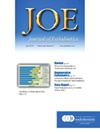Effects of the Irrigation Needle Design on Root Canal Disinfection and Cleaning
IF 3.5
2区 医学
Q1 DENTISTRY, ORAL SURGERY & MEDICINE
引用次数: 0
Abstract
Introduction
This ex vivo study evaluated the disinfecting and cleaning effects of root canal preparation using sodium hypochlorite irrigation with 3 different needle designs.
Methods
Mesial roots from extracted mandibular molars with Vertucci class II configuration were anatomically matched based on micro-computed tomography (micro-CT) analyses and distributed into 3 groups (n = 18/group). The canals were contaminated with a mixed bacterial culture for 30 days and then subjected to preparation using 2.5% sodium hypochlorite irrigation with open-ended flat needle (3 mm short of the working length - WL), closed-ended side-vented irrigation needle (1 mm short of the WL), or a closed-ended plastic needle with 2 lateral outlets (TruNatomy) (1 mm short of the WL). Bacteriological samples were taken from the canals before (S1) and after preparation (S2). After another micro-CT scan, the roots were sectioned and samples were also taken from the apical canal segment (S3). Bacterial reduction was assessed by quantitative real-time polymerase chain reaction. The amount of accumulated hard tissue debris was evaluated by micro-CT.
Results
A substantial reduction in bacterial counts was observed in all 3 groups when comparing S1 with S2 (99.95%, 98.93%, and 98.90% in the open-ended, closed-ended, and TruNatomy needle groups, respectively) (P < .01). No significant differences were observed between groups for bacterial reduction in the full and apical canal (P > .05). There were no intergroup differences in the amount of accumulated hard tissue debris either (P > .05). The open-ended needle group showed significantly more specimens with quantitative real-time polymerase chain reaction negative results for bacteria in S3 than TruNatomy (P < .05).
Conclusion
When used up to an appropriate insertion depth, the 3 needle types result in similar antibacterial and cleaning performance, provided variables such as needle size and irrigant type, volume and flow rate are controlled. Exclusive analysis of the apical segment, including the isthmus, revealed that the open-ended needle yielded more cases negative for bacteria.
灌洗针设计对根管消毒和清洁的影响
简介:这项体内外研究评估了使用三种不同设计的针头进行 NaOCl 冲洗根管预备的消毒和清洁效果:根据显微计算机断层扫描(micro-CT)分析,对拔出的下颌臼齿 Vertucci II 类构造的中根进行解剖匹配,并将其分为三组(n=18/组)。用混合细菌培养液污染牙管 30 天,然后用开口扁平针(距工作长度 - WL 短 3 毫米)、闭口侧排灌洗针(距工作长度短 1 毫米)或闭口双侧出口塑料针(TruNatomy)(距工作长度短 1 毫米)进行 2.5% NaOCl 冲洗。在制备前(S1)和制备后(S2),分别从牙槽骨中提取细菌样本。在进行另一次微型 CT 扫描后,对牙根进行切片,并从根尖管段取样(S3)。细菌减少情况通过实时定量聚合酶链反应(qPCR)进行评估。显微 CT 评估了硬组织碎屑的累积量:结果:与 S1 和 S2 相比,所有三组的细菌数量均有大幅减少(开口针组、闭口针组和 TruNatomy 针组分别为 99.95%、98.93% 和 98.90%)(P < 0.01)。在全管和根尖管细菌减少方面,各组间无明显差异(P > 0.05)。在硬组织碎屑累积量方面,组间也没有差异(P > 0.05)。开口针组在 S3 中显示 qPCR 阴性结果的细菌标本明显多于 TruNatomy 组(P < 0.05):结论:只要控制好针头大小、冲洗液类型、容量和流速等变量,在达到适当的插入深度时,三种类型的针头具有相似的抗菌和清洁性能。对包括峡部在内的根尖部分进行的专门分析表明,开口针产生的阴性细菌更多。
本文章由计算机程序翻译,如有差异,请以英文原文为准。
求助全文
约1分钟内获得全文
求助全文
来源期刊

Journal of endodontics
医学-牙科与口腔外科
CiteScore
8.80
自引率
9.50%
发文量
224
审稿时长
42 days
期刊介绍:
The Journal of Endodontics, the official journal of the American Association of Endodontists, publishes scientific articles, case reports and comparison studies evaluating materials and methods of pulp conservation and endodontic treatment. Endodontists and general dentists can learn about new concepts in root canal treatment and the latest advances in techniques and instrumentation in the one journal that helps them keep pace with rapid changes in this field.
 求助内容:
求助内容: 应助结果提醒方式:
应助结果提醒方式:


